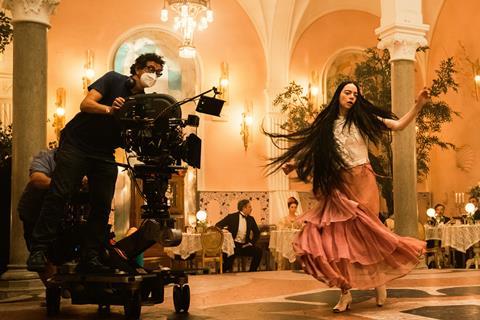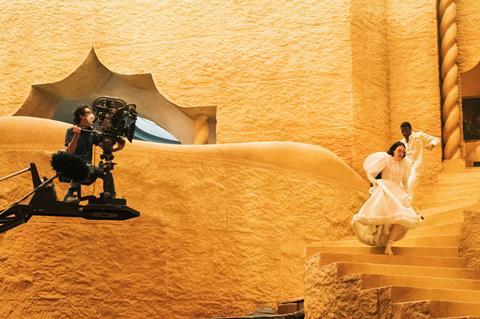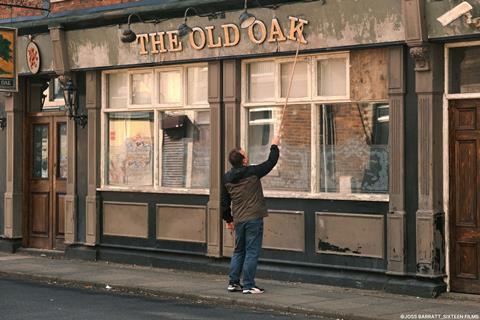Cinematographer Robbie Ryan tells Screen how he bent the rules with Yorgos Lanthimos for Poor Things, found a familiar family vibe with Ken Loach on The Old Oak, and enjoyed the spontaneity of shooting Andrea Arnold’s next film.

Robbie Ryan, cinematographer of Poor Things, says his second collaboration with director Yorgos Lanthimos was like “a cinematography masterclass all the time… I’m learning from him constantly. He knows how to push stocks and bend the rules of photography.” (Lanthimos is such a photography buff that he was taking large-format still photos of the actors using a Chamonix camera, and developing them in his spare time.)
The Irish cinematographer had shot Lanthimos’s 2018 feature The Favourite — in the process picking up Oscar and Bafta cinematography nominations — and was keen to join the director as he pushed even more creative boundaries on Searchlight Pictures’ Poor Things. “Yorgos is expecting everybody to put as much as they can into working as hard as they can,” says Ryan. “It’s not in an authoritarian way, it’s in a creative way. He makes you excited about what you’re doing.”
Poor Things had a number of learning curves and challenges, even for an experienced cinematographer like Ryan, who has worked on more than 120 features, shorts and music videos for directors including Andrea Arnold, Ken Loach, Andrew Dominik and Mike Mills. On Poor Things, Ryan had to shoot on 35mm in both colour and black and white, create unusual lenses, work with rare film stocks, and shoot in studios where his director was trying to avoid typical lighting.
Lanthimos had already been thinking about the world of Poor Things for a decade, and convinced Ryan to join the journey after The Favourite. Ryan started work on his vision for the film in January 2021, ahead of shooting from October of the same year.
“All that luxury of time, preparing for the shoot, is something you don’t always get on other films,” says Ryan. “When I read the Poor Things script, I could see it was ramped up to the next level and would be a massive, exciting challenge.”
Poor Things, adapted from the 1992 Alasdair Gray novel, follows Bella Baxter — played by Emma Stone (also a producer). Bella is a young woman brought back to life, anew, by daring scientist Dr Godwin Baxter (Willem Dafoe) in Victorian-era London. On her accelerated journey of development, she travels through Europe to Lisbon, then on an ocean liner to Alexandria, and back home via a Paris brothel.
The design of the cities of London, Lisbon, Paris and Alexandria, and the ocean liner, were spearheaded by the double production designer team of Shona Heath and James Price and built at several studio spaces in Hungary.
“The whole idea is that it’s meant to be unreal. It’s not meant to be a realistic look,” says Ryan. One key reference Lanthimos gave to the heads of department was Francis Ford Coppola’s 1992 film Bram Stoker’s Dracula. “It’s wonderful because it’s not real, it’s evocative and you can let your imagination loose,” he continues. “It’s like tapping into when you read a book and you might imagine your wildest dreams — Dracula definitely touched on that.”
Working completely in studios was new for Ryan, and of course Lanthimos had an extra-special challenge — he did not want it lit like usual sets, instead targeting a natural look that was pre-lit from outside windows or from studio ceiling rails to evoke daylight. In some cases, Ryan had to fit lights on these sets up to eight weeks before filming (producer Ed Guiney agreed it was an extra cost that was justified). “I do a lot of filmmaking that’s natural light,” says Ryan, who has been Bafta-longlisted for Poor Things. “And we wanted to create that, that was the rulebook, and it was just on a big scale that took a lot of lights.”
Under the lens

Lanthimos also pushed his cinematographer to create lenses that did not already exist. “I admire Yorgos’s drive to find new lenses and find new ideas and push it,” says Ryan. “Shooting on 35mm, there are a limited amount of lenses you can choose from, and he was keen to find a lens that was very, very wide because he likes a wide aspect ratio, but that was also a zoom lens so he could go from wide and zoom into a really tight shot. Optically, that’s the holy grail.
“We tried to create something that was like a 10mm up to a 150mm or a 200mm,” he continues. “We ended up finding something that was a compromise but it did pretty well.”
The ambition was usually achieved with one camera — some of the dinner scenes needed a second, but that was something Ryan usually tried to avoid. “Having multiple cameras can take up too much time, because you have to tell other people what to do,” he says. “Whereas I love being an operator, and I’m very much comfortable on a dolly or wherever the camera is. If I’m on duty somewhere else, I get a little bit disorientated and I don’t have as much focus.”
Even on crane shots — such as one that saw Bella run down a flight of stone steps into Alexandria — Ryan liked to sit on high. “When you see cranes nowadays, it’s almost always robots,” he says. “But there is an old way of doing it where you sit on a crane, and that’s a heck of a lot of fun for me.”
By staying with the camera, Ryan was able to develop his relationship with the actors. “I absolutely love the privilege of being in front of an actor doing what they do,” says Ryan. “I try to make their world comfortable. Emma has a lot of intimate scenes in Poor Things, so we wanted to make that as comfortable a space as we could for her, so it was easier for her to perform.”
Ryan and Lanthimos’s deep knowledge of cinematographic history saw them pick and choose exactly the kit that would achieve the look they wanted — their “workhorse camera”, as Ryan calls it, was an Arricam ST. “It’s an amazingly well-designed piece of kit, 25 years old and they don’t make them anymore,” he says.
They also shot selectively in VistaVision — a format that is not used anymore but possible on Arri’s adapted Beaumonte Vista. “There is more detail in the negative and it’s a larger format, really beautiful,” Ryan explains.
For film stock, they asked Kodak for a bespoke 35mm version of Ektachrome. “There’s only one or two laboratories in the world that can process this film stock — luckily for us, a laboratory was quite close to our studio in Hungary.”
About 30% of Poor Things was shot on the Ektachrome stock. “It is essentially colour-reversal film — positive, not negative — and much more vibrant, and preserves the original look,” says Ryan. “There is a lot of colour and detail in the original picture.”
The black-and-white scenes were shot on Kodak Double-X 5222 black-and-white film stock. “A lot of people nowadays will shoot on a colour format and they’ll just turn it black-and-white,” asserts Ryan. “But the properties of black-and-white negative are so beautiful.”
Further adventures

Always the student, Ryan is keen to find new sources of inspiration. His wide range of recent work includes Mike Mills’ black-and-white C’mon C’mon, Nick Cave documentary This Much I Know To Be True, Thomas Hardiman’s UK indie Medusa Deluxe, Ken Loach’s The Old Oak and Andrea Arnold’s upcoming Bird. “If your projects are very varied, you’ve got great scope — of different ideas and films,” he explains. But Ryan will not be pinned down on his favourite style of shooting: “It all comes down to the story and the script.”
Ryan has shot all of Arnold’s fiction features, beginning with 2006’s Red Road, as well as the 2003 Oscar-winning short Wasp. Her latest Bird — starring Barry Keoghan and Franz Rogowski — filmed in London in late summer 2023, opposite Tilbury docks on the River Thames. It involved some enjoyable chaos. “Cinematography for Andrea is very handheld, very instinctive, very spontaneous,” says Ryan. “I’m in heaven doing that kind of stuff. With this film, Andrea has tried to do something with her cinema and push it even more, so it was quite a challenge. I think she’s really brave.”
Reuniting with Ken Loach for The Old Oak, the pair’s fifth collaboration, was “like revisiting a nice family, like going to the pub with your uncles. It’s one of my favourite environments, to be on a camera on one of his films. That set is just so chilled.
“Ken spends a huge amount of energy writing down his shots and doing a little story where the camera goes,” Ryan continues. “It’s important to him that he’s got that in his head. I love that he will sometimes choose a location purely based on the lighting.”
Ryan reteamed with Lanthimos on his next film Kind Of Kindness (previously And), which shot in late 2022 in New Orleans. Once again Stone is in the cast, but the story remains under wraps.
Next Ryan works with John Maclean, for whom he shot Slow West (2015). The Scottish director is now making his long-anticipated follow-up Tornado, which starts shooting this month. Ryan calls the film “sort of a samurai movie in Scotland up a hill”, and adds: “John has a great sensibility — he’s very different to Yorgos because he only wants to do one take — he knows what he wants.
“But it makes me nervous,” says Ryan, with a laugh. “I want to get one back-up!”
Even though he is much in demand for features, the cinematographer will continue filming shorts and music videos. “I did three shorts in 2023. I like the atmosphere on those shorts because it’s a passion — there’s no other reason to do it except for everyone trying to make the best film they can.”






![The Brightest SunScreen[Courtesy HKIFF]](https://d1nslcd7m2225b.cloudfront.net/Pictures/274x183/3/5/0/1448350_thebrightestsunscreencourtesyhkiff_312678.jpg)


















No comments yet